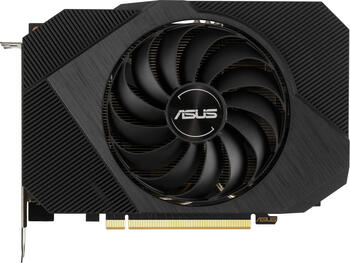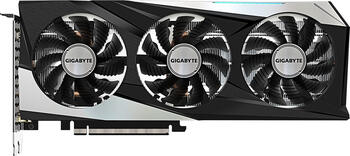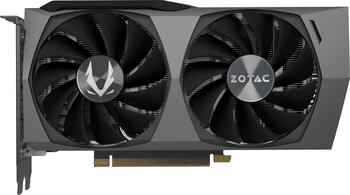- Anschlüsse 1x HDMI 2.1, 3x DisplayPort 1.4a
- Grafik NVIDIA GeForce RTX 3060 - 12GB GDDR6 - Desktop
- Chip GA106-300-A1, 28SM, 276mm²
- Fertigung 8nm (Samsung)
- Chiptakt 1320MHz, Boost: 1807MHz (OC Mode)
- Speicher 12GB GDDR6, 1875MHz, 15Gbps (15000MHz effektiv), 192bit, 360GB/?s
- Shader-Einheiten/TMUs/ROPs 3584/?112/?64
- TDP/TGP 170W (NVIDIA)
- Externe Stromversorgung 1x 8-Pin PCIe
- Kühlung 2x Axial-Lüfter (100mm)
- Gesamthöhe Dual-Slot (2.0 Slots)
- Abmessungen 200x123x38mm
- Besonderheiten Echtzeit-Raytracing, Raytracing Cores (28), Tensor Cores (112), NVIDIA G-Sync, NVIDIA VR-Ready, AV1 Decode, HDCP 2.3, 0dB-Zero-Fan-Modus (bis 55°C), Backplate, LED-Beleuchtung (RGB), Boost-Takt übertaktet (+30MHz)
- Schnittstelle PCIe 4.0 x16
- Rechenleistung 12.95 TFLOPS (FP32), 202 GFLOPS (FP64)
- DirectX 12 Ultimate (12_2)
- OpenGL 4.6
- OpenCL 3.0
- Vulkan 1.2
- Shader Modell 6.6
- LHR -> Low Hash Rate
weitere Informationen
- Anschlüsse: 1x DVI, 1x HDMI 2.0b, 1x DisplayPort 1.4a
- Grafik: NVIDIA GeForce GTX 1650 - 4GB GDDR6 - Desktop
- Chip: TU117-300-A1 Turing, 14SM, 200mm
- Fertigung: 12nm (TSMC)
- Chiptakt: 1410MHz, Boost| 1620MHz
- Speicher: 4GB GDDR6, 1500MHz, 12Gbps (12000MHz effektiv), 128bit, 192GB/s
- Shader-Einheiten/TMUs/ROPs: 896/56/32
- TDP/TGP: 75W (NVIDIA), 75W (MSI)
- Externe Stromversorgung: 1x 6-Pin PCIe
- Kühlung: 2x Axial-Lüfter (75mm)
- Gesamthöhe: Dual-Slot
- H.265 encode/decode, NVIDIA G-Sync, NVIDIA VR-Ready, HDCP 2.2, Boost-Takt übertaktet (+30MHz)
- Schnittstelle: PCIe 3.0 x16
- Rechenleistung: 2.9 TFLOPS (FP32), 91 GFLOPS (FP64)
weitere Informationen
- Anschlüsse: 2x HDMI 2.1, 3x DisplayPort 1.4a
- Grafik: NVIDIA GeForce RTX 3080 Ti - 12GB GDDR6X - Desktop
- Chip: GA102-225-A1 Ampere, 80SM, 628mm
- Fertigung: 8nm (Samsung)
- Chiptakt: 1365MHz, Boost| 1785MHz (OC Mode)
- Speicher: 12GB GDDR6X, 1188MHz, 19Gbps (19008MHz effektiv), 384bit, 912GB/s
- Shader-Einheiten/TMUs/ROPs: 10240/320/112
- TDP/TGP: 350W (NVIDIA)
- Externe Stromversorgung: 2x 8-Pin PCIe
- Kühlung: 3x Axial-Lüfter (95mm)
- Gesamthöhe: Triple-Slot (2.7 Slots)
- Echtzeit-Raytracing (80 Cores), Tensor Cores (320), NVIDIA G-Sync, NVIDIA VR-Ready, AV1 Decode, HDCP 2.3, 0dB-Zero-Fan-Modus (bis 55C), Backplate, LED-Beleuchtung (RGB), Boost-Takt übertaktet (+120MHz)
- Schnittstelle: PCIe 4.0 x16
- Rechenleistung: 36.56 TFLOPS (FP32), 571 GFLOPS (FP64)
weitere Informationen
- Anschlüsse: 1x HDMI 2.1, 3x DisplayPort 1.4a
- Grafik: NVIDIA GeForce RTX 3080 Ti - 12GB GDDR6X - Desktop
- Chip: GA102-225-A1 Ampere, 80SM, 628mm
- Fertigung: 8nm (Samsung)
- Chiptakt: 1365MHz, Boost| 1770MHz
- Speicher: 12GB GDDR6X, 1188MHz, 19Gbps (19008MHz effektiv), 384bit, 912GB/s
- Shader-Einheiten/TMUs/ROPs: 10240/320/112
- TDP/TGP: 350W (NVIDIA), 350W (MSI)
- Externe Stromversorgung: 3x 8-Pin PCIe
- Kühlung: 3x Axial-Lüfter (90mm)
- Gesamthöhe: Triple-Slot
- Echtzeit-Raytracing (80 Cores), Tensor Cores (320), NVIDIA G-Sync, NVIDIA VR-Ready, AV1 Decode, HDCP 2.3, 0dB-Zero-Fan-Modus, Backplate, LED-Beleuchtung (RGB), inkl. Grafikkarten-Halterung, Boost-Takt übertaktet (+105MHz)
- Schnittstelle: PCIe 4.0 x16
- Rechenleistung: 36.25 TFLOPS (FP32), 566 GFLOPS (FP64)
weitere Informationen
- GPU: NVIDIA GeForce RTX 3060
- Speicher: 12GB GDDR6, 192bit, 15Gbps, 1875MHz, 360GB/s
- Takt Basis: 1320MHz (Standard-Profil), 1320MHz (OC-Profil)
- Takt Boost: 1852MHz (Standard-Profil), 1882MHz (OC-Profil)
- Übertaktung: +105MHz Boost (OC-Profil), +75MHz Boost (Standard-Profil)
- Kühlung: 3x Axial-Lüfter (95mm) mit 0dB-Zero-Fan-Modus (bis 50C)
- TDP/TGP: 170W (NVIDIA)
- Stromanschlüsse: 1x 8-Pin PCIe
- Anschlüsse: 2x HDMI 2.1, 3x DisplayPort 1.4a
- Anbindung: PCIe 4.0 x16
- Taktprofile (Default Mode/OC Mode), LED-Beleuchtung (RGB), Backplate, mit LHR (Lite Hash Rate)
- Gesamthöhe: Triple Slot (2.7 Slots)
- Bauform: PCIe-Karte (full height)
- Slotblende: full height
- Rechenleistung: 13.49 TFLOPS (FP16), 13.49 TFLOPS (FP32), 0.21 TFLOPS (FP64)
- Chip-Daten:
- Chip-Architektur: Ampere (ab 2020/Q3)
- Chip-Bezeichnung: GA104-150-KC-A1
- Chip-Konfiguration: 28SM (3584 ALUs / 112 TMUs / 64 ROPs), 28 RT Cores, 112 Tensor Cores, 3MB L2-Cache
- Chip-Fertigung: Samsung 8nm
- Chip-Größe: 392mm, monolithisch, 17.4 Mrd. Transistoren
- Chip-Funktionen: Raytracing (2nd Gen NVIDIA RTX), NVIDIA Tensor (3rd Gen), HDCP 2.3
- API-Unterstützung: DirectX 12 Ultimate (12_2) / CUDA 8.6 / Vulkan 1.3 / OpenCL 3.0 / OpenGL 4.6 / Shader Model 6.7
- Transcoding-Engine: 1x NVENC (7th Gen, max. Sessions| 5), 1x NVDEC (5th Gen), Info
- Encoding: H.265 (4K YUV 4|2|0 / 4K YUV 4|4|4 / 4K Lossless / 8K / HEVC 10bit support / HEVC B Frame support), H.264 (YUV 4|2|0 / YUV 4|4|4 / Lossless)
- Decoding: AV1 (8bit / 10bit), H.265 (8bit 4|2|0 / 10bit 4|2|0 / 12bit 4|2|0 / 8bit 4|4|4 / 10bit 4|4|4 / 12bit 4|4|4), H.264, VP9 (8bit / 10bit / 12bit), VP8, VC-1, MPEG-2, MPEG-1
- Multi-GPU-Anbindung: -
- Erstveröffentlichung (Serie): 01.09.2021, UVP| 329 USD (NVIDIA)
- Grafik: NVIDIA GeForce RTX 3060 - 12GB GDDR6 - Desktop (GA104)
weitere Informationen
- Anschlüsse: 2x HDMI 2.1, 3x DisplayPort 1.4a
- Grafik: NVIDIA GeForce RTX 3060 - 12GB GDDR6 - Desktop (LHR)
- Chip: GA106-302-A1 Ampere, 28SM, 276mm
- Fertigung: 8nm (Samsung)
- Chiptakt: 1320MHz, Boost| 1912MHz (OC Mode)
- Speicher: 12GB GDDR6, 1875MHz, 15Gbps (15000MHz effektiv), 192bit, 360GB/s
- Shader-Einheiten/TMUs/ROPs: 3584/112/48
- TDP/TGP: 170W (NVIDIA)
- Externe Stromversorgung: 1x 8-Pin PCIe
- Kühlung: 3x Axial-Lüfter (95mm)
- Gesamthöhe: Triple-Slot (2.7 Slots)
- Echtzeit-Raytracing (28 Cores), Tensor Cores (112), NVIDIA G-Sync, NVIDIA VR-Ready, AV1 Decode, HDCP 2.3, 0dB-Zero-Fan-Modus (bis 50C), Backplate, LED-Beleuchtung (RGB), Boost-Takt übertaktet (+135MHz)
- Schnittstelle: PCIe 4.0 x16
- Rechenleistung: 13.71 TFLOPS (FP32), 214 GFLOPS (FP64)
weitere Informationen
- Anschlüsse: 1x HDMI 2.1, 3x DisplayPort 1.4a
- Grafik: NVIDIA GeForce RTX 3060 - 12GB GDDR6 - Desktop (LHR)
- Chip: GA106-302-A1 Ampere, 28SM, 276mm
- Fertigung: Samsung 8nm
- Chiptakt: 1320MHz, Boost| 1807MHz (OC Mode)
- Speicher: 12GB GDDR6, 1875MHz, 15Gbps (15000MHz effektiv), 192bit, 360GB/s
- Shader-Einheiten/TMUs/ROPs: 3584/112/48
- TDP/TGP: 170W (NVIDIA)
- Externe Stromversorgung: 1x 8-Pin PCIe
- Kühlung: 1x Axial-Lüfter (100mm)
- Gesamthöhe: Triple-Slot (2.55 Slots)
- Echtzeit-Raytracing (28 Cores), Tensor Cores (112), NVIDIA G-Sync, NVIDIA VR-Ready, AV1 Decode, HDCP 2.3, Backplate, Boost-Takt übertaktet (+30MHz)
- Schnittstelle: PCIe 4.0 x16
- Rechenleistung: 12.95 TFLOPS (FP32), 202 GFLOPS (FP64)
weitere Informationen
- Anschlüsse: 1x HDMI 2.1, 3x DisplayPort 1.4a
- Grafik: NVIDIA GeForce RTX 3070 Ti - 8GB GDDR6X - Desktop
- Chip: GA104-400-A1 Ampere, 48SM, 392mm
- Fertigung: Samsung 8nm
- Chiptakt: 1575MHz, Boost| 1770MHz
- Speicher: 8GB GDDR6X, 1188MHz, 19Gbps (19008MHz effektiv), 256bit, 608GB/s
- Shader-Einheiten/TMUs/ROPs: 6144/192/96
- TDP/TGP: 290W (NVIDIA), 290W (MSI)
- Externe Stromversorgung: 2x 8-Pin PCIe
- Kühlung: 3x Axial-Lüfter (90mm)
- Gesamthöhe: Triple-Slot
- Echtzeit-Raytracing (48 Cores), Tensor Cores (192), NVIDIA G-Sync, NVIDIA VR-Ready, AV1 Decode, HDCP 2.3, 0dB-Zero-Fan-Modus, Backplate, inkl. Grafikkarten-Halterung
- Schnittstelle: PCIe 4.0 x16
- Rechenleistung: 21.75 TFLOPS (FP32), 340 GFLOPS (FP64)
weitere Informationen
- Anschlüsse: 1x HDMI 2.1, 3x DisplayPort 1.4a
- Grafik: NVIDIA GeForce RTX 3070 - 8GB GDDR6 - Desktop (LHR)
- Chip: GA104-302-A1 Ampere, 46SM, 392mm
- Fertigung: 8nm (Samsung)
- Chiptakt: 1500MHz, Boost| 1785MHz
- Speicher: 8GB GDDR6, 1750MHz, 14Gbps (14000MHz effektiv), 256bit, 448GB/s
- Shader-Einheiten/TMUs/ROPs: 5888/184/96
- TDP/TGP: 220W (NVIDIA), 240W (INNO3D)
- Externe Stromversorgung: 2x 8-Pin PCIe
- Kühlung: 4x Axial-Lüfter (3x 90mm + 1x 45mm)
- Gesamthöhe: Triple-Slot
- Echtzeit-Raytracing (46 Cores), Tensor Cores (184), NVIDIA G-Sync, NVIDIA VR-Ready, AV1 Decode, HDCP 2.3, Backplate, LED-Beleuchtung (RGB), Boost-Takt übertaktet (+60MHz)
- Schnittstelle: PCIe 4.0 x16
- Rechenleistung: 21.02 TFLOPS (FP32), 328 GFLOPS (FP64)
weitere Informationen
- Anschlüsse 1x HDMI 2.1, 3x DisplayPort 1.4a
- Grafik NVIDIA GeForce RTX 3070 - 8GB GDDR6 - Desktop (LHR)
- Chip GA104-302-A1, 46SM, 392mm²
- Fertigung 8nm (Samsung)
- Chiptakt 1500MHz, Boost: 1785MHz
- Speicher 8GB GDDR6, 1750MHz, 14Gbps (14000MHz effektiv), 256bit, 448GB/s
- Shader-Einheiten/TMUs/ROPs 5888/184/96
- TDP/TGP 220W (NVIDIA), 240W (INNO3D)
- Externe Stromversorgung 2x 8-Pin PCIe
- Kühlung 3x Axial-Lüfter (90mm)
- Gesamthöhe Triple-Slot
- Abmessungen 300x135mm
- Besonderheiten Echtzeit-Raytracing, Raytracing Cores (46), Tensor Cores (184), NVIDIA G-Sync, NVIDIA VR-Ready, AV1 Decode, HDCP 2.3, Backplate, LED-Beleuchtung (RGB), Boost-Takt übertaktet (+60MHz)
- Schnittstelle PCIe 4.0 x16
- Rechenleistung 21.02 TFLOPS (FP32), 328 GFLOPS (FP64)
- DirectX 12 Ultimate (12_2)
- OpenGL 4.6
- OpenCL 3.0
- Vulkan 1.2
- Shader Modell 6.6
- LHR -> Low Hash Rate
weitere Informationen
- Anschlüsse: 1x HDMI 2.1, 3x DisplayPort 1.4a
- Grafik: NVIDIA GeForce RTX 3060 Ti - 8GB GDDR6 - Desktop (LHR)
- Chip: GA104-202-A1 Ampere, 38SM, 392mm
- Fertigung: 8nm (Samsung)
- Chiptakt: 1410MHz, Boost| 1680MHz
- Speicher: 8GB GDDR6, 1750MHz, 14Gbps (14000MHz effektiv), 256bit, 448GB/s
- Shader-Einheiten/TMUs/ROPs: 4864/152/80
- TDP/TGP: 200W (NVIDIA), 200W (INNO3D)
- Externe Stromversorgung: 1x 8-Pin PCIe
- Kühlung: 2x Axial-Lüfter (90mm)
- Gesamthöhe: Dual-Slot
- Echtzeit-Raytracing (38 Cores), Tensor Cores (152), NVIDIA G-Sync, NVIDIA VR-Ready, AV1 Decode, HDCP 2.3, 0dB-Zero-Fan-Modus, Backplate, Boost-Takt übertaktet (+15MHz)
- Schnittstelle: PCIe 4.0 x16
- Rechenleistung: 16.34 TFLOPS (FP32), 255 GFLOPS (FP64)
weitere Informationen
- Anschlüsse: 2x HDMI 2.1, 2x DisplayPort 1.4a
- Grafik: NVIDIA GeForce RTX 3060 - 12GB GDDR6 - Desktop (LHR)
- Chip: GA106-302-A1 Ampere, 28SM, 276mm
- Fertigung: 8nm (Samsung)
- Chiptakt: 1320MHz, Boost| 1837MHz
- Speicher: 12GB GDDR6, 1875MHz, 15Gbps (15000MHz effektiv), 192bit, 360GB/s
- Shader-Einheiten/TMUs/ROPs: 3584/112/48
- TDP/TGP: 170W (NVIDIA)
- Externe Stromversorgung: 1x 8-Pin PCIe
- Kühlung: 3x Axial-Lüfter (80mm)
- Gesamthöhe: Dual-Slot
- Echtzeit-Raytracing, Raytracing Cores (28), Tensor Cores (112), NVIDIA G-Sync, NVIDIA VR-Ready, AV1 Decode, HDCP 2.3, 0dB-Zero-Fan-Modus, Backplate, LED-Beleuchtung (RGB), Boost-Takt übertaktet (+60MHz)
- Schnittstelle: PCIe 4.0 x16
- Rechenleistung: 13.17 TFLOPS (FP32), 206 GFLOPS (FP64)
weitere Informationen
- Anschlüsse: 2x HDMI 2.1, 3x DisplayPort 1.4a
- Grafik: NVIDIA GeForce RTX 3070 Ti - 8GB GDDR6X - Desktop
- Chip: GA104-400-A1 Ampere, 48SM, 392mm
- Fertigung: Samsung 8nm
- Chiptakt: 1575MHz, Boost| 1875MHz (OC Mode)
- Speicher: 8GB GDDR6X, 1188MHz, 19Gbps (19008MHz effektiv), 256bit, 608GB/s
- Shader-Einheiten/TMUs/ROPs: 6144/192/96
- TDP/TGP: 290W (NVIDIA)
- Externe Stromversorgung: 3x 8-Pin PCIe
- Kühlung: 3x Axial-Lüfter (100mm)
- Gesamthöhe: Triple-Slot (2.9 Slots)
- Echtzeit-Raytracing (48 Cores), Tensor Cores (192), NVIDIA G-Sync, NVIDIA VR-Ready, AV1 Decode, HDCP 2.3, 0dB-Zero-Fan-Modus (bis 55C), Backplate, Lüftersteuerung (2x 4-Pin), LED-Beleuchtung (RGB), Boost-Takt übertaktet (+105MHz)
- Schnittstelle: PCIe 4.0 x16
- Rechenleistung: 23.04 TFLOPS (FP32), 360 GFLOPS (FP64)
weitere Informationen
- Anschlüsse: 2x HDMI 2.1, 3x DisplayPort 1.4a
- Grafik: NVIDIA GeForce RTX 3070 Ti - 8GB GDDR6X - Desktop
- Chip: GA104-400-A1 Ampere, 48SM, 392mm
- Fertigung: 8nm (Samsung)
- Chiptakt: 1575MHz, Boost| 1815MHz (OC Mode)
- Speicher: 8GB GDDR6X, 1188MHz, 19Gbps (19008MHz effektiv), 256bit, 608GB/s
- Shader-Einheiten/TMUs/ROPs: 6144/192/96
- TDP/TGP: 290W (NVIDIA)
- Externe Stromversorgung: 2x 8-Pin PCIe
- Kühlung: 3x Axial-Lüfter (95mm)
- Gesamthöhe: Triple-Slot (2.7 Slots)
- Echtzeit-Raytracing (48 Cores), Tensor Cores (192), NVIDIA G-Sync, NVIDIA VR-Ready, AV1 Decode, HDCP 2.3, 0dB-Zero-Fan-Modus (bis 55C), Backplate, LED-Beleuchtung (RGB), Boost-Takt übertaktet (+45MHz)
- Schnittstelle: PCIe 4.0 x16
- Rechenleistung: 22.3 TFLOPS (FP32), 348 GFLOPS (FP64)
weitere Informationen
- Anschlüsse: 1x HDMI 2.1, 3x DisplayPort 1.4a
- Grafik: NVIDIA GeForce RTX 3070 - 8GB GDDR6 - Desktop (LHR)
- Chip: GA104-302-A1 Ampere, 46SM, 392mm
- Fertigung: 8nm (Samsung)
- Chiptakt: 1500MHz, Boost| 1755MHz
- Speicher: 8GB GDDR6, 1750MHz, 14Gbps (14000MHz effektiv), 256bit, 448GB/s
- Shader-Einheiten/TMUs/ROPs: 5888/184/96
- TDP/TGP: 220W (NVIDIA), 220W (Zotac)
- Externe Stromversorgung: 2x 8-Pin PCIe
- Kühlung: 2x Axial-Lüfter (90mm)
- Gesamthöhe: Dual-Slot
- Echtzeit-Raytracing (46 Cores), Tensor Cores (184), NVIDIA G-Sync, NVIDIA VR-Ready, AV1 Decode, HDCP 2.3, 0dB-Zero-Fan-Modus, Backplate, Boost-Takt übertaktet (+30MHz)
- Schnittstelle: PCIe 4.0 x16
- Rechenleistung: 20.67 TFLOPS (FP32), 323 GFLOPS (FP64)
weitere Informationen
- Anschlüsse: 1x HDMI 2.1, 3x DisplayPort 1.4a
- Grafik: NVIDIA GeForce RTX 3060 Ti - 8GB GDDR6 - Desktop (LHR)
- Chip: GA104-202-A1 Ampere, 38SM, 392mm
- Fertigung: 8nm (Samsung)
- Chiptakt: 1410MHz, Boost| 1665MHz
- Speicher: 8GB GDDR6, 1750MHz, 14Gbps (14000MHz effektiv), 256bit, 448GB/s
- Shader-Einheiten/TMUs/ROPs: 4864/152/80
- TDP/TGP: 200W (NVIDIA), 200W (Zotac)
- Externe Stromversorgung: 1x 8-Pin PCIe
- Kühlung: 2x Axial-Lüfter (90mm)
- Gesamthöhe: Dual-Slot
- Echtzeit-Raytracing (38 Cores), Tensor Cores (152), NVIDIA G-Sync, NVIDIA VR-Ready, AV1 Decode, HDCP 2.3, 0dB-Zero-Fan-Modus, Backplate
- Schnittstelle: PCIe 4.0 x16
- Rechenleistung: 16.2 TFLOPS (FP32), 253 GFLOPS (FP64)
weitere Informationen
- Anschlüsse: 1x HDMI 2.1, 3x DisplayPort 1.4a
- Grafik: NVIDIA GeForce RTX 3070 - 8GB GDDR6 - Desktop (LHR)
- Chip: GA104-302-A1 Ampere, 46SM, 392mm
- Fertigung: 8nm (Samsung)
- Chiptakt: 1500MHz, Boost| 1755MHz
- Speicher: 8GB GDDR6, 1750MHz, 14Gbps (14000MHz effektiv), 256bit, 448GB/s
- Shader-Einheiten/TMUs/ROPs: 5888/184/96
- TDP/TGP: 220W (NVIDIA), 220W (Zotac)
- Externe Stromversorgung: 2x 8-Pin PCIe
- Kühlung: 2x Axial-Lüfter (90mm)
- Gesamthöhe: Dual-Slot
- Echtzeit-Raytracing (46 Cores), Tensor Cores (184), NVIDIA G-Sync, NVIDIA VR-Ready, AV1 Decode, HDCP 2.3, 0dB-Zero-Fan-Modus, Backplate, Boost-Takt übertaktet (+30MHz)
- Schnittstelle: PCIe 4.0 x16
- Rechenleistung: 20.67 TFLOPS (FP32), 323 GFLOPS (FP64)
weitere Informationen
- Anschlüsse: 1x HDMI 2.1, 3x DisplayPort 1.4a
- Grafik: NVIDIA GeForce RTX 3060 Ti - 8GB GDDR6 - Desktop (LHR)
- Chip: GA104-202-A1 Ampere, 38SM, 392mm
- Fertigung: 8nm (Samsung)
- Chiptakt: 1410MHz, Boost| 1695MHz
- Speicher: 8GB GDDR6, 1750MHz, 14Gbps (14000MHz effektiv), 256bit, 448GB/s
- Shader-Einheiten/TMUs/ROPs: 4864/152/80
- TDP/TGP: 200W (NVIDIA), 200W (Zotac)
- Externe Stromversorgung: 1x 8-Pin PCIe
- Kühlung: 2x Axial-Lüfter (90mm)
- Gesamthöhe: Dual-Slot
- Echtzeit-Raytracing (38 Cores), Tensor Cores (152), NVIDIA G-Sync, NVIDIA VR-Ready, AV1 Decode, HDCP 2.3, 0dB-Zero-Fan-Modus, Backplate, Boost-Takt übertaktet (+30MHz)
- Schnittstelle: PCIe 4.0 x16
- Rechenleistung: 16.49 TFLOPS (FP32), 258 GFLOPS (FP64)
weitere Informationen
- Anschlüsse: 1x HDMI 2.1, 3x DisplayPort 1.4a
- Grafik: NVIDIA GeForce RTX 3080 - 10GB GDDR6X - Desktop (LHR)
- Chip: GA102-202-KD-A1 Ampere, 68SM, 628mm
- Fertigung: 8nm (Samsung)
- Chiptakt: 1440MHz, Boost| 1725MHz
- Speicher: 10GB GDDR6X, 1188MHz, 19Gbps (19008MHz effektiv), 320bit, 760GB/s
- Shader-Einheiten/TMUs/ROPs: 8704/272/96
- TDP/TGP: 320W (NVIDIA), 320W (Zotac)
- Externe Stromversorgung: 2x 8-Pin PCIe
- Kühlung: 3x Axial-Lüfter (90mm)
- Gesamthöhe: Triple-Slot (2.5 Slots)
- Echtzeit-Raytracing (68 Cores), Tensor Cores (272), NVIDIA G-Sync, NVIDIA VR-Ready, AV1 Decode, HDCP 2.3, 0dB-Zero-Fan-Modus, Backplate, LED-Beleuchtung (RGB), Boost-Takt übertaktet (+15MHz)
- Schnittstelle: PCIe 4.0 x16
- Rechenleistung: 30.03 TFLOPS (FP32), 469 GFLOPS (FP64)
weitere Informationen
- Anschlüsse: 1x HDMI 2.1, 3x DisplayPort 1.4a
- Grafik: NVIDIA GeForce RTX 3070 - 8GB GDDR6 - Desktop (LHR)
- Chip: GA104-302-A1 ZollAmpere Zoll, 46SM, 392mm²
- Fertigung: 8nm (Samsung)
- Chiptakt: 1500MHz, Boost| 1785MHz
- Speicher: 8GB GDDR6, 1750MHz, 14Gbps (14000MHz effektiv), 256bit, 448GB/s
- Shader-Einheiten/TMUs/ROPs: 5888/184/96
- TDP/TGP: 220W (NVIDIA), 240W (Zotac)
- Externe Stromversorgung: 2x 8-Pin PCIe
- Kühlung: 2x Axial-Lüfter (105mm)
- Gesamthöhe: Triple-Slot (2.5 Slots)
- Echtzeit-Raytracing, Raytracing Cores (46), Tensor Cores (184), NVIDIA G-Sync, NVIDIA VR-Ready, AV1 Decode, HDCP 2.3, 0dB-Zero-Fan-Modus, Backplate, LED-Beleuchtung (RGB), Boost-Takt übertaktet (+60MHz)
- Schnittstelle: PCIe 4.0 x16
- Rechenleistung: 21.02 TFLOPS (FP32), 328 GFLOPS (FP64)
weitere Informationen
Die Kategorie "NVidia PCIexpress Grafikkarte" umfasst eine Auswahl an Grafikkarten des Herstellers NVidia, die über eine PCI Express-Schnittstelle an den Computer angeschlossen werden. Hier sind einige wichtige Informationen zur Kategorie "NVidia PCIexpress Grafikkarte":
1. NVidia Grafikkarten: NVidia ist einer der führenden Hersteller von Grafikkarten und bekannt für seine leistungsstarken GPUs (Graphics Processing Units). NVidia bietet eine breite Palette von Grafikkarten für verschiedene Anwendungen an, darunter Gaming, professionelle Grafikdesign, 3D-Modellierung, Videobearbeitung und mehr.
2. PCI Express-Schnittstelle: Die Grafikkarten in dieser Kategorie nutzen die PCI Express-Schnittstelle, die heutzutage die gängigste Verbindungsmethode für Grafikkarten ist. PCI Express bietet hohe Bandbreite und ermöglicht eine effiziente Datenübertragung zwischen der Grafikkarte und dem Motherboard des Computers.
3. Leistungsmerkmale: Die NVidia Grafikkarten bieten verschiedene Leistungsmerkmale wie GPU-Takt, Anzahl der CUDA-Kerne (parallel arbeitende Prozessoren), Grafikspeichergröße, Speichertyp (GDDR5, GDDR6 usw.), Anschlussmöglichkeiten (HDMI, DisplayPort, DVI, VGA usw.) und unterstützte Auflösungen. Die Leistungsfähigkeit variiert je nach Modell und richtet sich nach den Anforderungen der jeweiligen Anwendung.
4. Gaming- und Multimedia-Erlebnis: NVidia Grafikkarten sind für Gaming-Enthusiasten besonders interessant, da sie hochwertige Grafik- und Videoverarbeitungsfähigkeiten bieten. Sie ermöglichen ein reibungsloses Gameplay, hohe Bildraten, realistische Texturen und visuell beeindruckende Effekte. Sie sind auch für die Wiedergabe von hochauflösenden Videos und die Bearbeitung von Multimedia-Inhalten geeignet.
5. Treiber und Software: NVidia bietet regelmäßige Treiber- und Softwareupdates für seine Grafikkarten an, um die Leistung zu optimieren, neue Funktionen hinzuzufügen und Kompatibilität mit aktuellen Spielen und Anwendungen zu gewährleisten. Es ist wichtig, die neuesten Treiber von der NVidia-Website herunterzuladen und zu installieren, um das beste aus Ihrer Grafikkarte herauszuholen.
Beim Kauf einer NVidia PCIexpress Grafikkarte ist es wichtig, die technischen Spezifikationen, die Leistungsfähigkeit und die Kompatibilität mit Ihrem Computersystem und den Anforderungen Ihrer Anwendungen zu berücksichtigen. Lesen Sie auch Kundenbewertungen und Empfehlungen, um sich über die Erfahrungen anderer Benutzer mit der jeweiligen Grafikkarte zu informieren.






